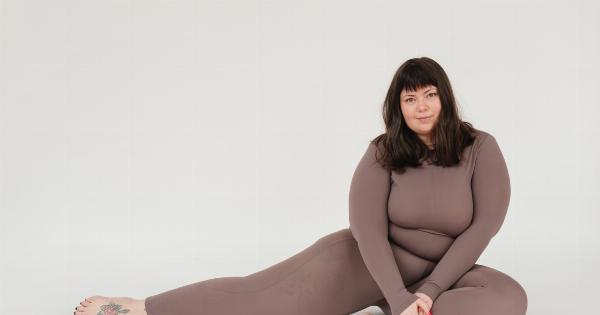Stretch marks, also known as striae, are a common skin concern that many people face. They can appear on various parts of the body, such as the abdomen, thighs, hips, breasts, and arms.
Stretch marks are caused by rapid stretching of the skin and are often associated with weight gain, pregnancy, puberty, or muscle growth.
While stretch marks are not harmful to your health, they can be unsightly and may affect your self-esteem. The good news is that there are measures you can take to prevent stretch marks from forming in the first place.
In this article, we will explore some effective strategies for stopping stretch marks before they start.
1. Maintain a Healthy Weight
One of the main causes of stretch marks is rapid weight gain or loss. To minimize the risk of developing stretch marks, it is important to maintain a healthy weight.
Gradual weight gain allows the skin to adapt and stretch slowly over time, reducing the likelihood of stretch marks forming.
If you are trying to gain or lose weight, do it steadily and in a healthy manner. Avoid crash diets or fad weight loss programs as they can cause your skin to lose elasticity, making it more prone to stretch marks.
2. Hydrate Your Skin
Keeping your skin well-hydrated is essential for its overall health and elasticity. Dry skin is more susceptible to developing stretch marks. Make sure to drink plenty of water throughout the day to hydrate your body from within.
In addition to drinking water, you can also moisturize your skin externally. Use a nourishing moisturizer or body oil to keep your skin supple and hydrated. Pay extra attention to areas prone to stretch marks, such as the abdomen, thighs, and buttocks.
3. Eat a Nutrient-rich Diet
Eating a balanced diet rich in nutrients can contribute to the health of your skin. Essential nutrients like vitamins A, C, and E play a vital role in maintaining skin elasticity and preventing stretch marks.
Incorporate foods such as carrots, citrus fruits, nuts, seeds, and leafy greens into your diet to ensure you are getting an adequate amount of these nutrients.
Furthermore, including foods high in collagen and elastin, such as bone broth, fish, and soy products, can help strengthen your skin’s structure and improve its elasticity.
4. Exercise Regularly
Regular exercise not only improves your overall health but also helps keep your skin healthy and firm. Engaging in activities that promote muscle growth and toning can prevent stretch marks by keeping your skin firm and tight.
Focus on exercises that target the areas prone to stretch marks, such as squats, lunges, and crunches. Building and toning your muscles in these areas can provide additional support to the skin, reducing the risk of stretch marks.
5. Gradual Weight Gain during Pregnancy
Pregnancy is a common time when women develop stretch marks due to the rapid expansion of the abdomen and breasts.
While it may be difficult to completely prevent stretch marks during pregnancy, you can minimize their appearance by gradually gaining weight.
Consult with your healthcare provider to determine a healthy weight gain plan during pregnancy. Avoid excessive weight gain and engage in gentle exercises specifically tailored for pregnant women to maintain muscle tone and skin elasticity.
6. Massage with Oils
Regularly massaging your skin with oils can improve circulation and help prevent stretch marks. Massage stimulates the production of collagen and improves the elasticity of the skin. It also aids in the absorption of oils, enhancing their effectiveness.
Choose oils that are known for their nourishing properties, such as almond oil, coconut oil, or argan oil. Gently massage the oil onto your skin in circular motions, paying particular attention to areas prone to stretch marks.
7. Avoid Prolonged Sun Exposure
Excessive sun exposure can weaken the collagen fibers in your skin, making it more susceptible to stretch marks.
Protect your skin from harmful UV rays by wearing sunscreen with a high SPF and avoiding prolonged sun exposure, especially during peak hours.
When spending time outdoors, cover your skin with light clothing or seek shade to minimize the risk of stretch marks caused by sun damage.
8. Consider Topical Treatments
There are various topical treatments available that claim to reduce the appearance of stretch marks or prevent them altogether. While their effectiveness may vary, some ingredients commonly found in these products have shown promising results.
Retinol, for example, is a derivative of vitamin A that is believed to stimulate collagen production and improve skin elasticity.
However, it is essential to consult with a dermatologist before using any topical treatments, particularly during pregnancy or if you have sensitive skin.
9. Stay Hydrated during Workouts
If you engage in intense workouts or weightlifting, it is important to stay hydrated. Dehydration can affect your skin’s elasticity and make it more prone to stretch marks.
Make sure to drink water before, during, and after your workouts to keep your skin hydrated and maintain its elasticity.
10. Embrace Your Body
Stretch marks are a natural part of life for many people, and it is essential to embrace your body just the way it is. Remember that stretch marks do not define your worth or beauty.
Learning to love and accept yourself will help boost your self-esteem and confidence.
While these strategies can help prevent stretch marks from forming, it is important to keep in mind that individual results may vary.
If you are concerned about existing stretch marks or need further advice on prevention, consult with a dermatologist or healthcare professional.





















